Methods for Noise Reduction in EDFs
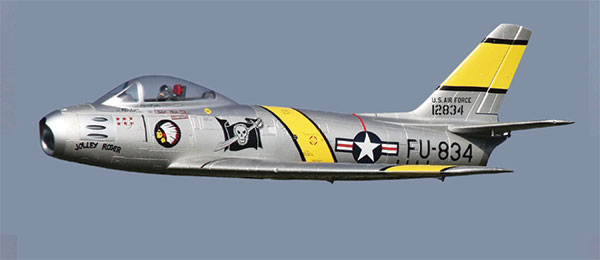
Written by Don Slusarczyk Tips for making your jet sound better and quieter Technical As seen in the April 2016 issue of Model Aviation.
Electric ducted-fan (EDF) models have been around for many years, and each year the technology advances. Long ago are the days of brushed motors, NiCd batteries, and models that flew more like powered gliders than jets. With the advent of brushless motors and LiPo batteries, EDF jets can fly more than 200 mph, so performance is no longer an issue. So what is the next big step in evolution for the EDF world? Sound. EDFs traditionally have had a rotor with four to six blades. These fans can be loud and have a whine that some have compared to the sound of a hair dryer or a leaf blower, especially in the 50mm to 70mm sizes. Some clubs have even restricted or banned the use of EDFs at their fields because of noise or nuisance sound concerns with nearby neighbors. Fortunately, there are several ways to reduce the noise that EDF models make. In order to reduce the sound, we must first identify what is generating it. There are multiple factors in EDF noise generation. A major one is fan imbalance. EDFs need to be dynamically balanced to eliminate sounds caused by vibration. Many people are familiar with static-balancing a two-blade propeller with a magnetic propeller balancer. Dynamic balancing is similar, but the rotor is spinning instead of sitting stationary, hence the term dynamic.
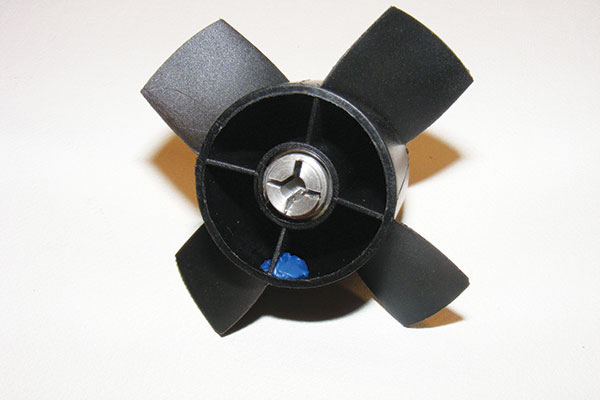
This rotor was dynamically balanced by adding a small amount of ballast. Ten to 200 mg of ballast is typically what is needed to get a fan in tune.
Dynamic balancing is analogous to having your car tires balanced. The tire and rim are mounted together and rotated, and then a weight is added in a specific location to remove the imbalance. The same process is used on an assembled EDF unit. A small amount of ballast is mounted to the inside of the rotor or rotor spinner, and by trial and error, the correct location and amount of required ballast are found. This can be a time-consuming process, but there are devices that can be purchased, as well as a cellphone app, to make the process easier. There are also several online EDF companies that provide dynamic balancing services for a fee. If an unbalanced fan is mounted into an aircraft, the noise and vibration are transferred throughout the entire airframe. Most EDF jet ARFs these days are made from foam and the foam resonates and amplifies the sound of the imbalanced fan. This turns the entire aircraft into a large noise generator. Having a properly balanced fan is a great first step in reducing overall EDF noise. Another noise source is the motor. Low-cost motors will likely have low-quality bearings. Depending on motor design, there might be two or three bearings in an EDF motor and all are potential sources of noise when the motor is running. As with an imbalanced fan, the bearing noise can be amplified through the airframe.
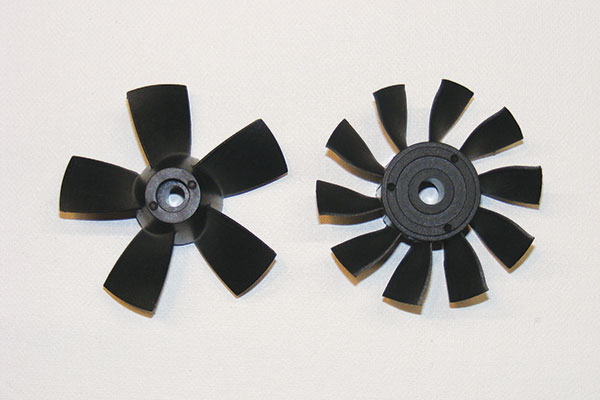
Increasing the number of blades on a rotor is a common way to reduce noise.
Dynamic balancing and motor noise can only take you so far when trying to reduce overall EDF noise. The biggest change in sound comes from the fan design. Fan units vary in the number of blades on the rotor as well as the number of stator vanes (the stationary blades in the fan housing). A fan with fewer rotor blades generally will be required to spin faster to generate the same thrust, so the resulting higher rpm leads to more noise. During the past couple of years, several EDF manufacturers have begun offering fans with more blades and more stators. Instead of four or six blades, rotors with 10 to 14 blades began to appear. The result is a fan that makes a more realistic “whoosh” sound.
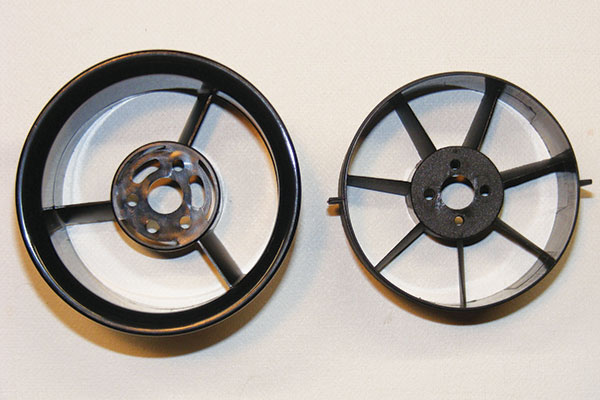
(L) Traditional EDF housings had only a few stators. The addition of more stators (R) helps reduce noise levels and maximize thrust.
Because of the rotor designs, a high blade-count fan (HBCF) runs at lower rpm, which helps to keep the overall noise levels down. In fact, when dynamically balanced, these fans can be so quiet that they can almost not be heard when flying the downwind leg at the flying field. So the sound reduction is a twofold gain—less noise at the field and a more realistic jet sound when flying. So what is the catch, you might ask? Well, the HBCFs do have some nuances to be aware of. Upgrading to a HBCF typically requires a new fan unit and motor. Merely swapping out a low blade-count rotor for a high blade-count rotor could leave you with a smoked motor and burned-out ESC because the amps and watts will go way up. The higher blade-count rotors have more torque load on them from the extra blades and higher pitch. Consequently, they require a lower Kv motor to obtain the same total watts. Matching the motor Kv to the rotor is crucial on these fans to ensure the extra watts and amps shown on the wattmeter are not being wasted as heat. Measuring the rpm and comparing that to the theoretical rpm at the same voltage with no rotor is a good way to know if your motor and fan combination is good or not.
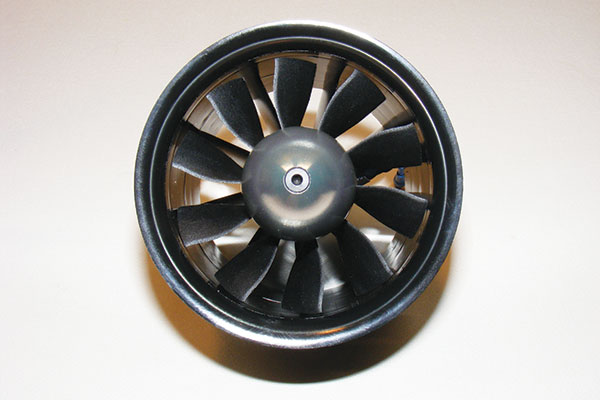
HBCF units not only have a realistic look, but produce a more true-to-life sound in the air.
For example, say your fan measures 33,000 rpm on a 2,800 Kv motor with a 4S LiPo that has a measured-under-load voltage of 14.4 volts. With no load, the motor should spin 2,800 x 14.4 = 40,320 rpm. The 33,000 measured rpm divided by the 40,320 theoretical rpm equals 81.8% efficiency, which is a good percentage. When the percentage dips to 75% or less, the Kv is too high for the rotor and those extra watts are wasted as heat. The next item to be aware of on an HBCF is the outlet diameter. The exit diameter at the back of the model affects the overall performance. HBCFs like large outlet diameters. This is the opposite of lower blade-count fans because they like the outlet to be tapered down. The correct size of the outlet is based on a term called fan-sweep area (FSA), which is the duct area minus the impeller hub area. Low blade-count fans prefer the FSA value to be in the 80% to 90% range. HBCFs do not tolerate the flow being choked down. They prefer the FSA to be in the 95% to 100% range. Having too small of an outlet on an HBCF will significantly drop the thrust, so making sure the outlet is sized correctly will allow you to maximize the fan’s performance.
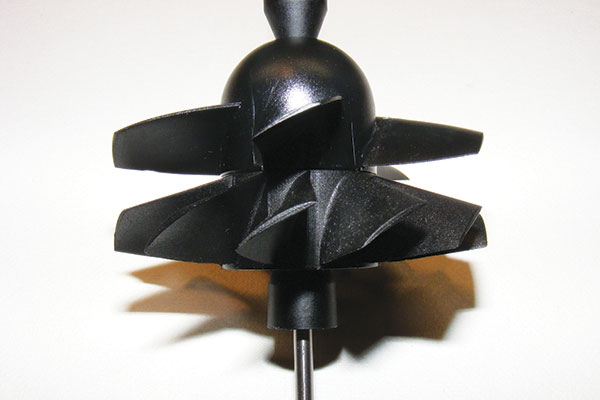
The differences in pitch distribution between a low-blade count and high blade-count rotor can be readily seen.
Because of the larger outlet diameter, one drawback to an HBCF is that top-end speed can be less. If you have two fans producing 3 pounds of thrust—an HBCF with a 100% FSA outlet and a low blade-count fan with an 80% FSA outlet—the efflux (or airspeed) coming out of the back of the model must be faster on the 80% FSA outlet because it is smaller in diameter. This higher efflux can translate into higher top-end speed. This phenomenon was one of the reasons why HBCFs were initially thought to be inefficient when they first came out. To maintain the same speed, 20% to 30% more watts had to be used to compensate for the larger outlet diameters. The larger FSA outlet of the HBCF offers some advantages, including providing good thrust throughout the flight range. Many will gladly sacrifice a little top-end speed for stronger vertical performance and an enhanced jetlike sound. Plus, many stock outlets on EDF ARFs already have a 100% FSA outlet or close to it, so little to no modification is required when retrofitting. Similar to the way an outlet that is too small can hurt performance, too small an inlet or restrictive ducting can hurt as well. HBCFs like to breathe. Restricting the inlet can cause a drop in performance because the fan will be starved of air.

Louvered air intakes allow the fans to take in the air they need and improve the sound.
One of the popular ways to aid airflow is the addition of cheater holes or louvers. These louvers allow scale or near-scale inlets to be used while allowing the fans to breathe. Recently, some 80mm and 90mm ARFs were released with 12-blade fans that have louvered cheater holes near the fan inlet to allow them to draw in air. The louvers have the added benefit of generating white noise, which adds to the realism. I have a few 64mm five-blade EDFs with a louvered cheater hole underneath that sound quite nice. Make sure that the fan fits smoothly into the ducting. You want the air to have a smooth transition into the fan. Having a sharp edge on the fan inlet can drastically reduce the thrust on an HBCF, so make sure the fan fits well into the model. Most fans come with a removable inlet lip and, if necessary, incorporate that into your installation.
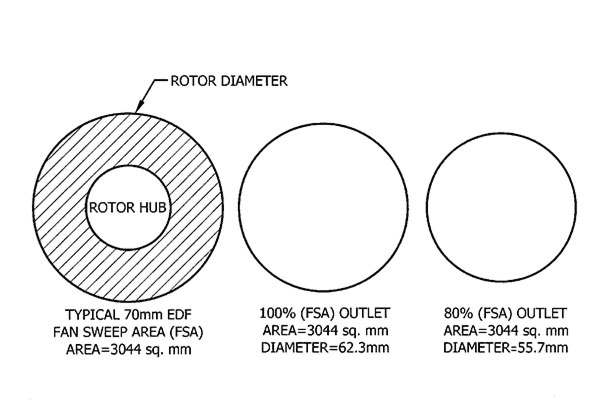
Graphical representation of the fan sweep area of a typical 70mm EDF, and 100% fan sweep area and 80% fan sweep area outlets.
As a test, I once ran a 12-blade 64mm fan with no inlet ring attached. On a 4S LiPo, it tested to 450 watts and roughly 16 ounces of thrust. With the inlet lip installed, it increased to 640 watts and 32 ounces of thrust, so that little lip made a huge difference. After you learn a few of the tricks involved with the new HBCF units, they are not much different to use than the older-style fan units. Some of the installation requirements are different than what many of us have grown accustomed to. If you are hesitant to try an EDF because of the sound, or simply want to improve the sound of your existing models, I hope these suggestions on where the noise is coming from, and the solutions to resolve the issue, will be of some benefit. As with any aspect of the hobby, technology is constantly changing and there have already been advances in the HBCF designs. Blade shape and pitch distribution are being fine-tuned to give more thrust with fewer amps. Within the next few years, all EDFs will have realistic jet sounds. The future in the EDF world looks bright. I encourage those who hesitated to fly EDFs in the past to take a look at what is now being offered and “whoosh” on into the jet age! —Don Slusarczyk [email protected]










7 comments
very good article
balancing equipment
Noise
Why don’t they use multiple
Why don’t they use multiple
Multiple rotors?
Efficiency
Add new comment